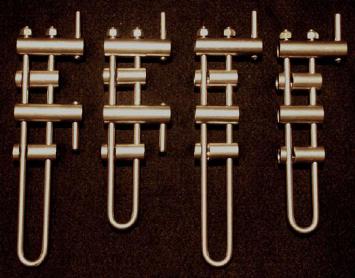Rack Safety
By Carroll Bassett
[Editors Note: This is a follow-up to the article titled:
"Danger! Don't Feed the Micro-rack!", by Scott McCrea,
that appeared in NYLON HIGHWAY NO. 48 - 2003]
Scott's point is well taken and his advice to use your other hand (aka balance hand, not your brake hand ) to not only spread the bars but to hold the fourth bar closed when feeding stiff rope makes good sense. If you routinely find yourself feeding rope (either because your rope is very stiff, you are a light person, or the rope weight acts to create too much friction) we strongly suggest that you switch frames to the longer version (BMS will be happy to switch your frame for $20US plus $6US shipping). This adds only about an ounce and just over an inch in length to your Micro-Rack and seems to solve most feeding issues our customers have had in the past.
 Pictured above: Long frame and short frame micro-racks |
If your problem persists and you are still uncomfortable with either a minirack or Micro-Rack a bobbin type device or a full sized rack may well suit your needs better.
Another approach to solving this possible problem is to make the fourth bar latch harder. This will increase the force that it takes to open and close the fourth bar with you find after tapping the bar it is too hard to engage with the frame properly you have probably closed the slot a bit too much and will need to open it a little. A rod slightly larger than the slot can be lightly tapped into it with the effect of opening the slot slightly. Check the latching action after each adjustment to make sure of the bar's proper functioning. Older racks should be checked periodically as wear from use can lessen this latching force. Anyone who feels uncomfortable with making these adjustments themselves is welcome to return their Micro-Racks to BMS along with the return shipping (see above) for a free tune up.
Mini-racks made by other manufacturers with aluminum bars may have some issues with cracking so the manufacturers should be consulted first before any adjustments are made. Using a QAS (quick attachment safety) is highly recommended when approaching an edge especially before one has fully loaded the rope. For those of you unfamiliar with this technique I will briefly describe its components and their use. A QAS generally consists of a personal ascender or rope grab which has the ability to be attached to a rope quickly with one hand and a tether that securely connects it to the users harness. The length of the tether should allow attachment above your descender but not be so long as to not allow easy reach when fully loaded on rope. It is generally clipped to the balance hand side of the rappelers harness to make it easy and fast to attach to the rope when on rappel. As one moves down the rope towards the lip the cam is held slightly open with the balance hand to allow progress. To stop progress the cam is allowed to engage the rope. This adds somewhat to the complexity of a system and can be taught on steep slopes for gaining experience before a real drop.
The auto-block is another rappel safety technique worth knowing and simply puts the ascender below the rappel device. Rather than a mechanical ascender a small prussic (6-7mm acc. cord) is tied onto the rope below the descender and then attached to the leg loop on the rappelers brakehand side usually with an oval or triangular quick link . Be sure to tie your prussik carefully and dress it properly. This should be rigged as short as possible so not to allow the prussik to ride up into your descender when loaded. To move down the rope the prussik is broken with the brakehand and rope allowed to slide through. To stop simply let go of the prussic and it will grab the rope stopping progress. Since the prussic only receives a small proportion of the users total weight (most of the users weight is on the descender above) it is relatively easy to continue a rappel after stopping by breaking the grip of the prussic. Again, practice with this technique on a steep slope to gain expertise and confidence. This is especially useful for the first person into a pit to use as there will be no one to bottom belay you in the event of an emergency.
Readers should be careful to understand these concepts fully before using them and always practice the highest standards of safety when on rope. Whenever in doubt seek out competent training and advice. Be safe and enjoy.
|
Carroll Bassett for BMS BMS HC 68 Box 64B Friars Hill, W.V. 24938 (304) 497-4311 omc01207@mail.wvnet.edu |
Return to the Top of the Page
Return to the NH #49 Contents Page
Copyright © 2004 Vertical Section of the NSS, Inc. - All Rights Reserved.